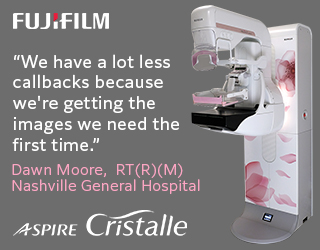|
E-Newsletter • March 2025 |
▼ ADVERTISEMENT

Editor's E-Note
The Society of Interventional Radiology (SIR) meeting is around the corner, and this month, we have some interesting IR news. First, the Chinese College of Interventionalists has put forward a consensus statement that aims to standardize and promote conebeam CT use in liver malignancy therapies. Also, in case you missed it at RSNA, researchers in Germany released a study demonstrating the effectiveness of genicular artery embolization for patients with knee osteoarthritis.
For more of the latest imaging news, visit us on X, formerly known as Twitter, and/or Facebook.
If you happen to be at the SIR conference, stop by booth #1333 and say hello. We’d like to hear from you. Enjoy the newsletter.
— Dave Yeager, editor |
|
|
| In This E-Newsletter
|
▼ ADVERTISEMENT
 |
|
|
▼ ADVERTISEMENT

CBCT Shows Promise for Liver Malignancy Interventions
Interventional therapies, including transarterial chemoembolization (TACE), yttrium-90 selective internal radiation therapy, and ablation, are pivotal in treating liver malignancies. These interventions are commonly guided by imaging techniques such as digital subtraction angiography (DSA), CT, ultrasonography, or MRI. Nonetheless, each imaging modality has inherent limitations. DSA, for example, provides 2D images of blood vessels and tumor staining, which may fall short of specific procedures. Ultrasonography struggles with visualizing small lesions and those near the diaphragm, while CT lacks real-time imaging capabilities.
▼ ADVERTISEMENT

Cone-beam CT (CBCT), a volumetric imaging technique utilizing a cone-shaped X-ray beam, offers a promising alternative. It facilitates automatic detection and navigation of target vessels, fluoroscopy, and post-TACE embolization assessment, potentially overcoming some limitations of traditional imaging methods. Despite its recognized importance in liver malignancy interventions, CBCT's integration into clinical practice faces challenges such as limited awareness among interventional radiologists, inconsistent parameter standardization, and restricted application areas. To address these issues, the Chinese College of Interventionalists has issued a consensus statement to standardize and promote CBCT use in liver malignancy therapies. This statement, grounded in evidence-based practices and clinical expertise, has been registered on the International Practice Guidelines Registration and Transparency Platform (Registration number: PREPARE-2023CN980).
▼ ADVERTISEMENT
 |
Photoacoustic Technique Used in Stroke Imaging
Using light and sound, researchers at POSTEC, Pohang University of Science and Technology, were able to monitor brain changes in small animals experiencing ischemic stroke in real time.
Diagnosing Neurodegeneration With ALS Drug
Scientists at St Jude Children’s Research Hospital have found a way to enhance the ability to parse the signs of neurological disease by detecting oxidative stress. The amyotrophic lateral sclerosis drug edaravone reacts with certain chemicals in the brain to aid in imaging.
▼ ADVERTISEMENT

AI Can Detect Breast Cancer Where Humans Cannot
A study published in Nature Communication demonstrated the ability of AI systems to decrease the rate of false positives in ultrasound for breast cancer. |
“Thanks to this model, we can now interpret data from several thousands of families and children who are monitored at various hospitals—data that come from different scanners. The analysis of these large cohorts in children and adults was hampered by the major harmonization problem, which has now been resolved.”
— Gregory Lodygensky, MD, a clinical professor at the University of Montreal and clinician-researcher at the affiliated Saint Justine Hospital on a study on making MRI images “more similar” to make comparisons across institutions more reliable |
|
|
COVER STORY
AI in IR
In the same ways AI is aiding the wider field of radiology, it is aiding IR, increasing workflow efficiency, automating processes, and much more.
FEATURE
Timely Intervention
Facilities employing mobile stroke units are looking to increase funding to make this life-saving equipment more widely accessible.
|
|
|
| Advertising Opportunities |
Have a product or service you want to market to radiology professionals? Utilize the reach of Radiology Today Magazine to accomplish your marketing goals. Email our experienced account executives today at sales@gvpub.com or call 800-278-4400 for more information.
|
| © 2025 Radiology Today Magazine |
|
|